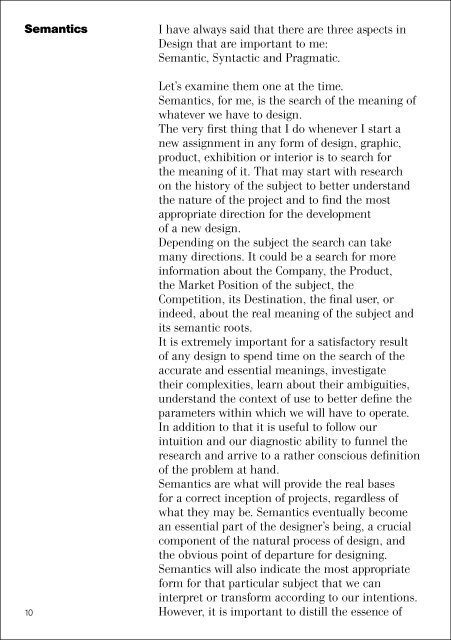1jyF4uV
1jyF4uV
1jyF4uV
You also want an ePaper? Increase the reach of your titles
YUMPU automatically turns print PDFs into web optimized ePapers that Google loves.
Semantics10I have always said that there are three aspects inDesign that are important to me:Semantic, Syntactic and Pragmatic.Let’s examine them one at the time.Semantics, for me, is the search of the meaning ofwhatever we have to design.The very first thing that I do whenever I start anew assignment in any form of design, graphic,product, exhibition or interior is to search forthe meaning of it. That may start with researchon the history of the subject to better understandthe nature of the project and to find the mostappropriate direction for the developmentof a new design.Depending on the subject the search can takemany directions. It could be a search for moreinformation about the Company, the Product,the Market Position of the subject, theCompetition, its Destination, the final user, orindeed, about the real meaning of the subject andits semantic roots.It is extremely important for a satisfactory resultof any design to spend time on the search of theaccurate and essential meanings, investigatetheir complexities, learn about their ambiguities,understand the context of use to better define theparameters within which we will have to operate.In addition to that it is useful to follow ourintuition and our diagnostic ability to funnel theresearch and arrive to a rather conscious definitionof the problem at hand.Semantics are what will provide the real basesfor a correct inception of projects, regardless ofwhat they may be. Semantics eventually becomean essential part of the designer’s being, a crucialcomponent of the natural process of design, andthe obvious point of departure for designing.Semantics will also indicate the most appropriateform for that particular subject that we caninterpret or transform according to our intentions.However, it is important to distill the essence ofthe semantic search through a complex process,most of which is intuitive, to infuse the design withall the required cognitive inputs, effortlessly andin the most natural way possible. It is as in music,when we hear the final sound, without knowingall the processes through which the composerhas gone before reaching the final result. Designwithout semantics is shallow and meaninglessbut, unfortunately it is also ubiquitous, and thatis why it is so important that young designerstrain themselves to start the design process in thecorrect way- the only way that can most enrichtheir design.Semantics, in design, means to understand thesubject in all its aspects; to relate the subject tothe sender and the receiver in such a way that itmakes sense to both. It means to design somethingthat has a meaning, that is not arbitrary, thathas a reason for being, something in which everydetail carries the meaning or has a precise purposeaimed at a precise target. How often we see designthat has no meaning: stripes and swash of colorsplashed across pages for no reason whatsoever.Well, they are either meaningless or incrediblyvulgar or criminal when done on purpose.Unfortunately, there are designers and marketingpeople who intentionally look down on theconsumer with the notion that vulgarity hasa definite appeal to the masses, and thereforethey supply the market with a continuos flow ofcrude and vulgar design. I consider this actioncriminal since it is producing visual pollution thatis degrading our environment just like all othertypes of pollution. Not all forms of vernacularcommunication are necessarily vulgar, althoughvery often that is the case. Vulgarity implies ablatant intention of a form of expression thatpurposely ignores and bypasses any form ofestablished culture. In our contemporary worldit becomes increasingly more difficult to findhonest forms of vernacular communication asonce existed in the pre-industrial world.


